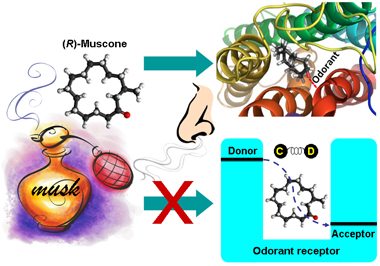UAlbany-led Study Finds Vibration Theory of Odor Perception Implausible
ALBANY, N.Y. (April 20, 2015) -- An international team of scientists led by University at Albany Distinguished Professor of Chemistry Eric Block, have demonstrated that the vibrational theory of olfaction, one of the two major theories explaining how the sense of smell functions, is not plausible.
 |
|
Researchers at UAlbany have demonstrated that the vibrational theory of olfaction, one of the two major theories explaining how the sense of smell functions, is not plausible in the April 20th edition of PNAS.
|
Published in the Proceedings of the National Academy of Sciences, the research compared the reactivity of muscone (the major component of musk fragrance, used in most perfumes) and its counterpart with all hydrogen atoms replaced by the heavy hydrogen isotope deteurium, toward the human musk olfactory receptor. The researchers found that the receptor responded identically to the two compounds, which is counter to expectations for the vibration theory, since carbon–deuterium bonds have very different vibrational frequencies than carbon–hydrogen bonds.
The vibration theory of olfaction suggests that a molecule's smell is based on its vibration frequency, similar to how color is interpreted through different frequencies of light.
In addition to Block, the other corresponding authors include Queens College-CUNY Professor Seogjoo Jang, Duke University Associate Professor Hiroaki Matsunami, and Shanghai Jiao Tong University Associate Professor Hanyi Zhuang.
The team obtained similar results with 25 other pairs of deuterated/undeuterated compounds when responding to their specific olfactory receptors. The vibration theory is based on the premise that just as in the sense of sight, wavelength translates into color, and in the sense of hearing, frequency translates into pitch, the sense of smell depends on molecular vibrations of odor molecules..
Other work by the cohort revealed flaws in the theoretical basis of the vibration theory. The team also clarified aspects of the second major theory of olfaction, termed the "shape theory of olfaction," which suggests that steric aspects of odorants are central in the so-called “hand-in-glove” or "lock and key" interaction of odors with odorant receptors. The researchers argue that in fact the entire range of interactions between molecules, both attractive and repulsive rather than just shape, come into play when odorants interact with their receptors, ultimately triggering perception of the odor.
This research is significant since humans can distinguish billions of odors. In animals, the sense of smell is an essential sense for detection of predators and other dangers, food sources, and mates.
Other coauthors include Bérénice Dethier, Sivaji Gundala, Stephene N. Lodge, and Sonia Flores Penalba from UAlbany, Sivakumar Sekharan, Mehmed Z. Ertem, Mehmet Ozbil, and Victor S. Batista from Yale University and Yi Pan, Shengju Li, Zhen Li, and Huihong Jiang from Shanghai Jiaotong University.
In the U.S. the research was funded by the National Science Foundation, the National Institutes of Health and the Department of Energy.
![]() For more news, subscribe to UAlbany's RSS headline feeds
For more news, subscribe to UAlbany's RSS headline feeds
A comprehensive public research university, the University at Albany-SUNY offers more than 120 undergraduate majors and minors and 125 master's, doctoral and graduate certificate programs. UAlbany is a leader among all New York State colleges and universities in such diverse fields as atmospheric and environmental sciences, business, education, public health,health sciences, criminal justice, emergency preparedness, engineering and applied sciences, informatics, public administration, social welfare and sociology, taught by an extensive roster of faculty experts. It also offers expanded academic and research opportunities for students through an affiliation with Albany Law School. With a curriculum enhanced by 600 study-abroad opportunities, UAlbany launches great careers.


